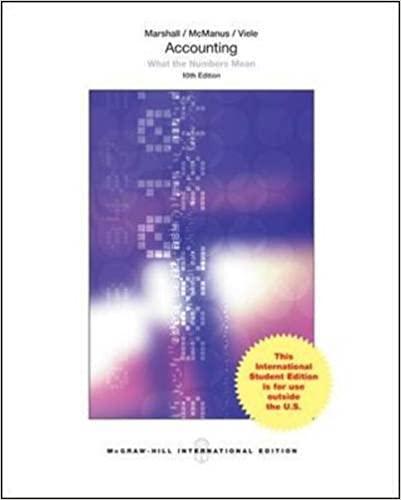Question
example from book step 1 Calculate the percentage of total weight for each item by dividing each items weight by the total weight. This will
example from book step 1 Calculate the percentage of total weight for each item by dividing each items weight by the total weight. This will give the percentage in its decimal form. (For example, for the fat row, first convert 1 # 9 oz to 25 oz. Then convert the total weight from 6 # 2 oz to 98 oz. Divide the fat weight by the total weight. 25 oz , 98 oz = 0.255 or 25.5%.) Perform this calculation for each row, and enter it in the % of Total Weight column. Then, total the percentages for the bottom row. The percentages should equal 100% or close to it, as a result of rounding.
Step 2: Step 1: Locate the purchase price per pound for each by-product on a purveyors database. This is the price a business would pay to purchase each of the by-products separately. Enter only the prices for the by-products that will be used in the foodservice operation; do not include the price for the main item being tested (in this case, the trimmed tenderloin). For this example, assume that the restaurant uses the fat in its Yorkshire pudding and the beef chunks in a tenderloin-mushroom vol-au-vent; the scraps go into the trash.
Step 3: Multiply the weight of each item, converted to pounds, by the purchase price per pound. (For the fat row, for example, 1 # 9 oz equals 1.5625 #. Assume the purveyors price list reveals that beef fat costs $0.17/#. 1.5625 # * $0.17/# = $0.266 or $0.27 total.) Enter the total value for each row. Remember that items with no purchase price will have no total value and that the main item tested will be left blank at this point. After these calculations, the Butchers test spreadsheet might look like Figure 4.3b
With the values of the by-products entered, we can now calculate the value of the main item, in this case, the trimmed tenderloin. We know from the top row that the total cost of the AP beef tenderloin with all of its component parts is $50.41; we just need to make sure that all of the parts values, when added separately, still equal $50.41. To ensure this, the value of the trimmed tenderloin (our main item) is set as the differ-ence between the total cost and the value of the by-products. In this example, the value of the trimmed tenderloin is: Total cost -Value of Fat $50.41 -$0.27 -Value of Beef Chunks -$1.02 Trimmed Tenderloin $49.12 The price of the trimmed main item is less than the AP total cost because the restaurant effectively received and paid for additional useable products in the initial purchase. Since the chef does not have to buy them separately, she can deduct their values here and charge them to the recipes where those by-products are ultimately used. To make this information valuable beyond this particular piece of tenderloin, there are a few more bits of information to calculate: Cost per useable pound and ounce (for the main item) and the cost multiplier. Cost per Useable # = Value of Main Item (determined in the yield test) Weight of Main Item in # In this example, cost per useable # = $49.12 , 3.0625 # = $16.039 or $16.04/#. Cost per useable ounce can be calculated by putting the weight of the main item in ounces in the denominator or simply by dividing the cost per useable # by 16
(as 16 oz = 1 #). In this example, $16.039 , 16 = $1.002 or $1.00/oz. The cost per useable ounce is $1.00. The cost multiplier is calculated by dividing this new cost per useable pound by the original AP cost per pound. Cost Multiplier = Cost per Useable # AP Cost per # In this example, the cost multiplier is $16.04 , $8.23 = 1.949 or 1.95. Figure 4.3c illustrates the completed butchers test spreadsheet, including cost per useable pound, cost per useable ounce, and the cost multiplier.
Having a cost multiplier for a given product is a huge time saver to calculate future costs per useable pound when the purveyors AP price shifts. Because the cost multiplier represents the ratio between the cost per useable pound and the AP cost per pound, a chef can simply multiply the cost multiplier times the new AP price to get the new cost per useable pound without having to conduct a whole new butchers yield test.
Example 4.8: The AP price for Beef Tenderloin was $8.23/#. The cost multiplier was determined to be 1.95. Now, the purveyor is increasing the price of beef tenderloin to $8.97/#. What is the new cost per useable pound and cost per useable ounce? Cost per Useable # = AP Cost per # * Cost Multiplier = $8.97/# * 1.95 = $17.49/# Cost per Useable ounce = Cost per Useable # , 16 (oz/#) = $17.49/# , 16 = $1.09/oz.
Photo is different problem, but same steps 
Step by Step Solution
There are 3 Steps involved in it
Step: 1

Get Instant Access to Expert-Tailored Solutions
See step-by-step solutions with expert insights and AI powered tools for academic success
Step: 2

Step: 3

Ace Your Homework with AI
Get the answers you need in no time with our AI-driven, step-by-step assistance
Get Started


